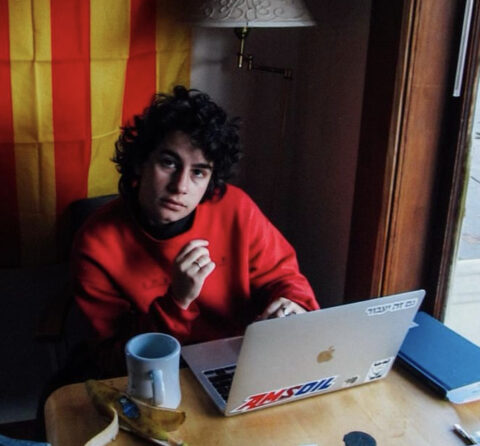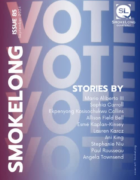What was the initial spark that inspired this work of flash fiction?
I recently completed an undergraduate thesis of speculative fiction about human-nature relation, and in my research I went down a bit of a rabbit hole of posthumanist theory. The more I read, the more I felt like the ideas contained in these texts—the decentering of human supremacy, the rejection of constructs of individuality in favor of recognizing the inherently relational experience of being a living thing—were quite useful and universal, but often presented in dense and inaccessible prose. So I tasked myself with writing something that illustrated these overarching concepts through character and setting rather than academic language. This exercise spawned a series of flash pieces centered around “Posthuman” as a character; this was one of the first ones I wrote.
The thread of transforming the body runs throughout the story. What do the images of bees (as opposed to actual bees) signify to you here?
I love this question, particularly the distinction made between non-human living creatures and the representations we make of them. This is something I think about a lot in my work, how we utilize other kinds of life to tell our own stories, and whether these uses are ethical—as in acknowledging and respecting these life forms as creatures with their own subjectivity, incomprehensible to us—or objectifying—positioning non-human life as fodder for human undertaking. In this particular piece, I felt that a hive of bees, symbolically, was a resonant metaphor for how I wanted to represent human existence: as co-created by many interacting parts, a kind of collective consciousness. As you point out, though, this piece is not about real bees, but rather leverages human perceptions and narratives of bees. I hoped to emphasize this distinction through the detail that all the references to bees here appear directly on human anatomy as tattoos. I don’t pretend to make any claims about the lives of real bees here; all I can speak to is my understanding of them through language and story and explore how those narratives might illuminate human experience.
Are there other artists, flash writers or not, that inspire your work?
Too many to list! My all-time favorite piece of flash fiction has got to be George Saunders’ “Sticks”—it’s such a perfect little window into a lifetime of complexity. Another author that has caught my attention recently is Lucy Corin, whose collection 100 Apocalypses and Other Apocalypses showed me just how wide-ranging flash can be in its emotional effect. Outside of literature, I draw a lot on mixed media for my inspiration, most often visual art and music. Increasingly, I don’t think it serves my work to consider these artistic categories in isolation, as the underlying impulse to create is overarching. Lately, I’ve been getting a lot of inspiration from the surrealist collages of Max Ernst, particularly his collection The Hundred Headless Woman. Surrealism in general has been a useful framework for my recent work; it allows one to get at some obvious truths from unexpected angles, and to re-envision narratives that create new possibilities for relating to the self and the surrounding world.
The main character stands outside of human-ness or gender. What do you think their posthuman status says about them?
I chose to present this character like this because I wanted to defamiliarize them from constructs of human identity—gender, presentation, even “humanness” itself. But simultaneously, I thought that voiding this character of unique, identifiably human features would increase their relatability to any possible reader, even as their experience stands in a sort of surrealist in-between space. As a genderqueer individual, I’m really interested in how social constructs shape our lives and behavior, and the ways in which deviating from or rejecting these norms entirely often move writing from a realist to a fantastical space, even if that “fantasy” is in fact more closely aligned with what it feels like to inhabit spaces outside of these norms. In my writing I try to remain cognizant of the ways in which identity categories, when applied to characters, inherently impact a reader’s experience. So Posthuman as a character is an attempt to portray an othered space as it is truly experienced, not as it is constructed in relation to “normalcy.”
In my mind, the character of Posthuman is both a nonfictional self-insert and a fantasy. They are human by species, not by self-identification. Their behavior and understanding of their own existence are not limited by the bounds of their body. They both are me and not me, they could be you and they could be everyone else. What makes this character “Posthuman” is not any defining aspect of their physicality or personality, but rather a pattern of relational thought available to anyone, and I hoped to show-not-tell this sort of thinking within the writing so that a reader might understand its potential intuitively, might even consider their own subjective experience through this posthuman lens.
What about flash fiction sparks your interest?
Flash fiction has been a recent undertaking for me. I’ve spent a lot more time writing short stories and dabbling in poetry as well. Although the former is where I feel I’ve done my best work, I love poetry because sometimes a piece will just land on the page after one sitting almost fully formed, as opposed to a narrative which nearly always requires a lot of reworking for consistency and clarity. Writing flash fiction made me realize that prose can also sometimes emerge like that too! This particular piece is a good example: It came to me almost entirely whole. I think that sometimes in rewriting it’s easy to focus on polish at the cost of some of the emotion that produced the piece in the first place. Flash fiction is so concentrated in its emotional impact—there’s something incredibly satisfying about a piece which is physically small on the page but contains a great deal of space within it.



 The SmokeLong Grand Micro Contest (The Mikey) is now an annual competition celebrating and compensating the best micro fiction and nonfiction online.
The SmokeLong Grand Micro Contest (The Mikey) is now an annual competition celebrating and compensating the best micro fiction and nonfiction online.